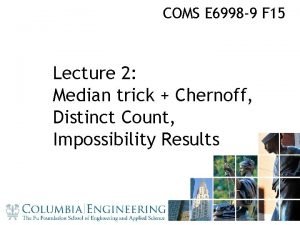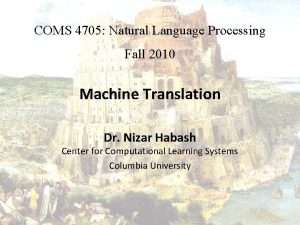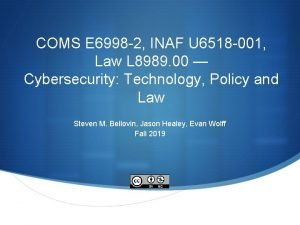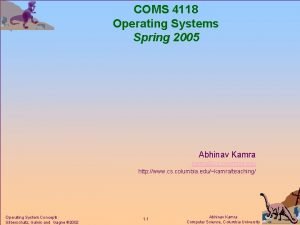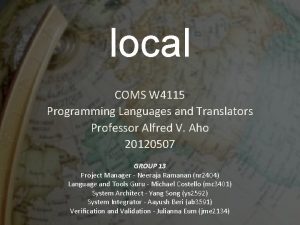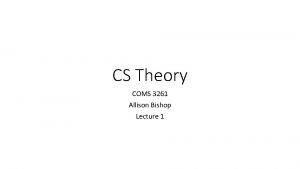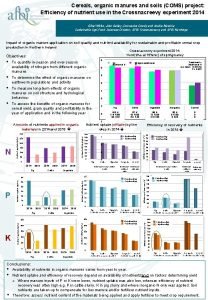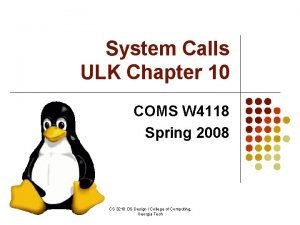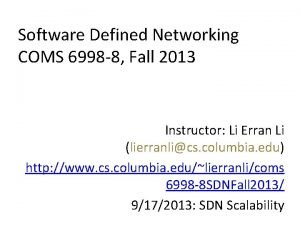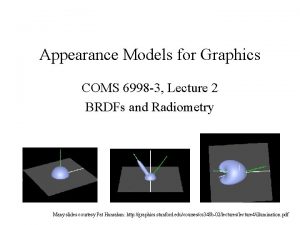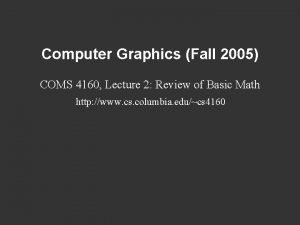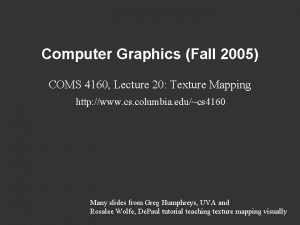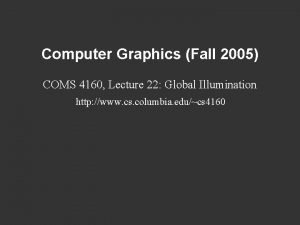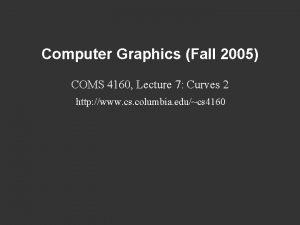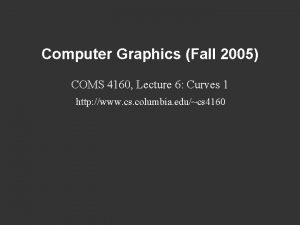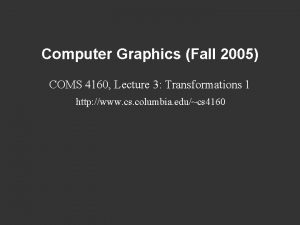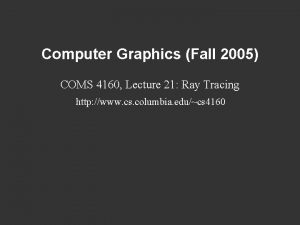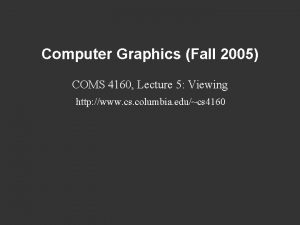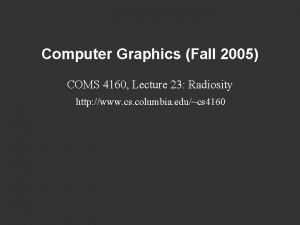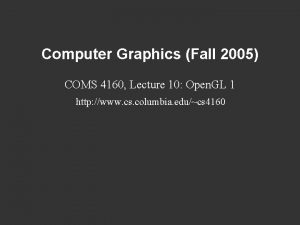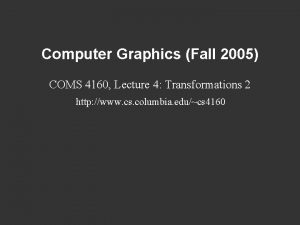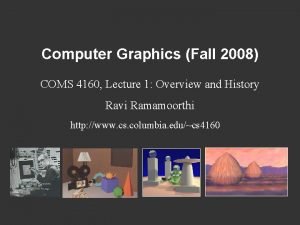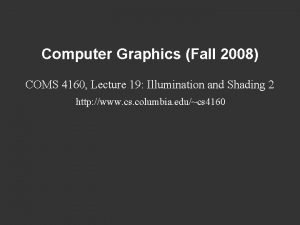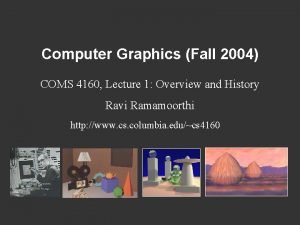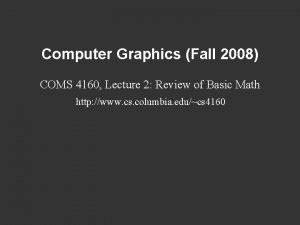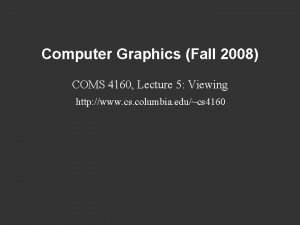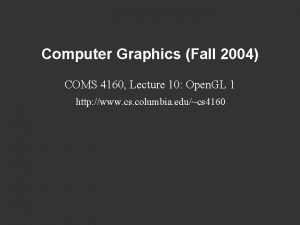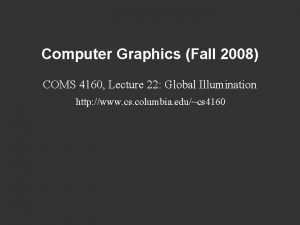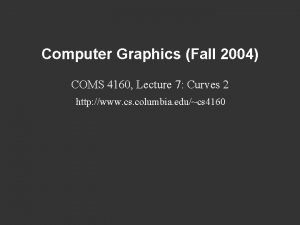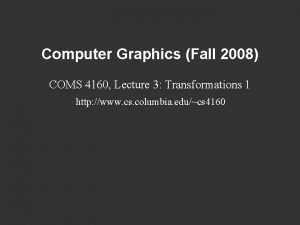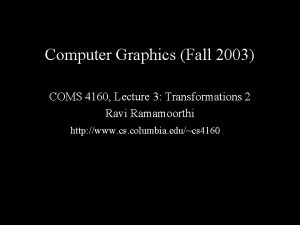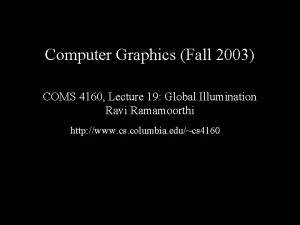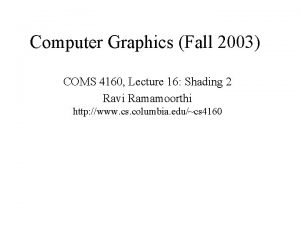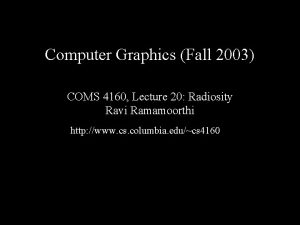Computer Graphics Fall 2005 COMS 4160 Lecture 16


























- Slides: 26

Computer Graphics (Fall 2005) COMS 4160, Lecture 16: Illumination and Shading 1 http: //www. cs. columbia. edu/~cs 4160

To Do § Work on HW 3, do well § Start early on HW 4 § Discussion of midterm § But remember HW 3, HW 4 more important

Course Outline § 3 D Graphics Pipeline Modeling (Creating 3 D Geometry) Rendering (Creating, shading images from geometry, lighting, materials)

Course Outline § 3 D Graphics Pipeline Rendering Modeling (Creating 3 D Geometry) (Creating, shading images from geometry, lighting, materials) Unit 1: Transformations Weeks 1, 2. Ass 1 due Sep 22 Unit 2: Spline Curves Unit 4: Lighting, Shading Unit 3: Open. GL Weeks 5 -7. Ass 3 due Nov 10 Weeks 8, 9. Written Ass 1 due Nov 16 Weeks 3, 4. Ass 2 due Oct 7 Midterm on units 1 -3: Oct 26 Ass 4: Interactive 3 D Video Game (final project) due Dec 13

Rendering: 1960 s (visibility) § Roberts (1963), Appel (1967) - hidden-line algorithms § Warnock (1969), Watkins (1970) - hidden-surface § Sutherland (1974) - visibility = sorting Images from Fv. DFH, Pixar’s Shutterbug Slide ideas for history of Rendering courtesy Marc Levoy

Rendering: 1970 s (lighting) 1970 s - raster graphics § Gouraud (1971) - diffuse lighting, Phong (1974) - specular lighting § Blinn (1974) - curved surfaces, texture § Catmull (1974) - Z-buffer hidden-surface algorithm

Rendering (1980 s, 90 s: Global Illumination) early 1980 s - global illumination § Whitted (1980) - ray tracing § Goral, Torrance et al. (1984) radiosity § Kajiya (1986) - the rendering equation

Outline § Preliminaries § Basic diffuse and Phong shading § Gouraud, Phong interpolation, smooth shading § Formal reflection equation (next lecture) § Texture mapping (in one week) § Global illumination (next unit) For today’s lecture, slides and chapter 9 in textbook

Motivation § Objects not flat color, perceive shape with appearance § Materials interact with lighting § Compute correct shading pattern based on lighting § This is not the same as shadows (separate topic) § Some of today’s lecture review of last Open. GL lec. § Idea is to discuss illumination, shading independ. Open. GL § Today, initial hacks (1970 -1980) § Next lecture: formal notation and physics

Linear Relationship of Light § Light energy is simply sum of all contributions § Terms can be calculated separately and later added together: § multiple light sources § multiple interactions (diffuse, specular, more later) § multiple colors (R-G-B, or per wavelength)

General Considerations Surfaces are described as having a position, and a normal at every point. N 1 (x 1, y 1, z 1) N 2 (x 2, y 2, z 2) Other vectors used § L = vector to the light source light position minus surface point position § E = vector to the viewer (eye) viewer position minus surface point position

Diffuse Lambertian Term § Rough matte (technically Lambertian) surfaces § Not shiny: matte paint, unfinished wood, paper, … § Light reflects equally in all directions § Obey Lambert’s cosine law § Not exactly obeyed by real materials -L N

Meaning of negative dot products § If (N dot L) is negative, then the light is behind the surface, and cannot illuminate it. § If (N dot E) is negative, then the viewer is looking at the underside of the surface and cannot see it’s front-face. § In both cases, I is clamped to Zero.

Phong Illumination Model § Specular or glossy materials: highlights § Polished floors, glossy paint, whiteboards § For plastics highlight is color of light source (not object) § For metals, highlight depends on surface color § Really, (blurred) reflections of light source Roughness

Idea of Phong Illumination § Find a simple way to create highlights that are viewdependent and happen at about the right place § Not physically based § Use dot product (cosine) of eye and reflection of light direction about surface normal § Alternatively, dot product of half angle and normal § Raise cosine lobe to some power to control sharpness or roughness

Phong Formula -L R E

Alternative: Half-Angle (Blinn-Phong) N H § In practice, both diffuse and specular components for most materials

Outline § Preliminaries § Basic diffuse and Phong shading § Gouraud, Phong interpolation, smooth shading § Formal reflection equation (next lecture) § Texture mapping (in one week) § Global illumination (next unit) Not in text. If interested, look at Fv. DFH pp 736 -738

Triangle Meshes as Approximations § Most geometric models are large collections of triangles. § Triangles have 3 vertices, each with a position, color, normal, and other parameters (such as n for Phong reflection). § The triangles are an approximation to the actual surface of the object.

Coloring Between the Lines § We know how to calculate the light intensity given: § § surface position normal viewer position light source position (or direction) § How do we shade a triangle between it’s vertices, where we aren’t given the normal?

Flat vs. Gouraud Shading gl. Shade. Model(GL_FLAT) gl. Shade. Model(GL_SMOOTH) Flat - Determine that each face has a single normal, and color the entire face a single value, based on that normal. Gouraud – Determine the color at each vertex, using the normal at that vertex, and interpolate linearly for the pixels between the vertex locations.

Gouraud Shading – Details 1 § Inter-vertex interpolation can be done in object space (along the face), but it is simpler to do it in image space (along the screen). § 2 ways for a vertex to get its normal: § given when the vertex is defined. § take all the normals from faces that share the vertex, and average them.

Gouraud Shading – Details 2 Scan line Actual implementation efficient: difference equations while scan converting

Gouraud and Errors § I 1 = 0 because (N dot E) is negative. § I 2 = 0 because (N dot L) is negative. § Any interpolation of I 1 and I 2 will be 0. I 1 = 0 I 2 = 0 area of desired highlight

2 Phongs make a Highlight § Besides the Phong Reflectance model (cosn), there is a Phong Shading model. § Phong Shading: Instead of interpolating the intensities between vertices, interpolate the normals. § The entire lighting calculation is performed for each pixel, based on the interpolated normal. (Open. GL doesn’t do this, but you can with current programmable shaders) I 1 = 0 I 2 = 0

Problems with Interpolated Shading § Silhouettes are still polygonal § Interpolation in screen, not object space: perspective distortion § Not rotation or orientation-independent § How to compute vertex normals for sharply curving surfaces? § But at end of day, polygons is much easier than explicitly representing curved objects like spline patches for rendering
 Graphics monitors and workstations in computer graphics
Graphics monitors and workstations in computer graphics Computer graphics introduction ppt
Computer graphics introduction ppt 01:640:244 lecture notes - lecture 15: plat, idah, farad
01:640:244 lecture notes - lecture 15: plat, idah, farad Coms 6998
Coms 6998 Sambit sahu columbia
Sambit sahu columbia Coms 4705
Coms 4705 Halfcoms
Halfcoms Coms
Coms Coms 6998
Coms 6998 Abhinav kamra
Abhinav kamra Coms 4115
Coms 4115 Coms 3261
Coms 3261 Coms project
Coms project Coms 4118
Coms 4118 Coms 6998
Coms 6998 Coms 6998
Coms 6998 Computer security 161 cryptocurrency lecture
Computer security 161 cryptocurrency lecture Computer aided drug design lecture notes
Computer aided drug design lecture notes Computer architecture lecture notes
Computer architecture lecture notes Microarchitecture vs isa
Microarchitecture vs isa Crt in computer graphics
Crt in computer graphics Projection in computer graphics
Projection in computer graphics What is plasma panel display in computer graphics
What is plasma panel display in computer graphics Exterior clipping
Exterior clipping Shear transformation in computer graphics
Shear transformation in computer graphics Glsl sincos
Glsl sincos Difference between scan conversion of ellipse and circle
Difference between scan conversion of ellipse and circle



